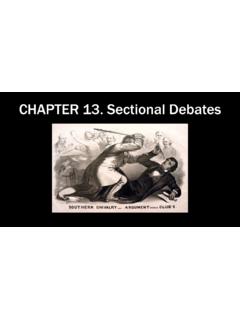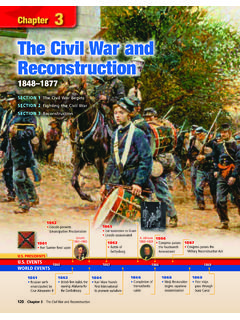Transcription of APUSH STUDY GUIDE: Period 5- 1844-1877 Readings …
1 APUSH STUDY GUIDE: Period 5- 1844-1877 Readings (Textbook and Zinn Only) Read textbook chapter 12 and answer Recall and Reflect questions (Due 11/20) Read textbook chapter 13 and answer Recall and Reflect questions (Due 11/22) Read textbook chapter 14 and answer Recall and Reflect questions (Due 11/24) One-Pager Choose one topic from Key Terms, Locations, & Vocabulary below (Due 11/15) Key-Terms, Locations, & Vocabulary (Due 11/15)1. Abolitionism 2. Carpetbaggers 3. Free-Soil movement 4. Domesticity 5. Ideological debate 6. Impeachment 7. Imperialism 8. Jingoism 9. Laissez-faire 10. Manifest Destiny 11. Nativism 12. Nullification 13. Personal Liberty laws 14. Popular sovereignty 15. Redemption 16. Sectional parties 17. Sectional tensions America s economic, social, and geographic growth lead to a growing schism between various regional and social groups. Racism and ethnocentrism lead to changes in laws and increase tensions between North and South.
2 Key Concept : The United States became more connected with the world, pursued an expansionist foreign policy in the Western Hemisphere, and emerged as the destination for many migrants from other countries. I. Popular enthusiasm for expansion, bolstered by economic and security interests, resulted in the acquisition of new territories, substantial migration westward, and new overseas initiatives. A. The desire for access to natural and mineral resources and the hope of many settlers for economic opportunities or religious refuge led to an increased migration to and settlement in the West. Evidence: B. Advocates of annexing western lands argued that Manifest Destiny and the superiority of American institutions compelled the United States to expand its borders westward to the Pacific Ocean. Evidence: C. The added large territories in the West through victory in the Mexican American War and diplomatic negotiations, raising questions about the status of slavery, American Indians, and Mexicans in the newly acquired lands.
3 Evidence: D. Westward migration was boosted during and after the Civil War by the passage of new legislation promoting Western transportation and economic development. Evidence: E. interest in expanding trade led to economic, diplomatic, and cultural initiatives to create more ties with Asia. Evidence: II. In the 1840s and 1850s, Americans continued to debate questions about rights and citizenship for various groups of inhabitants. A. Substantial numbers of international migrants continued to arrive in the United States from Europe and Asia, mainly from Ireland and Germany, often settling in ethnic communities where they could preserve elements of their languages and customs. Evidence: B. A strongly anti-Catholic nativist movement arose that was aimed at limiting new immigrants political power and cultural influence. Evidence: C. government interaction and conflict with Mexican Americans and American Indians increased in regions newly taken from American Indians and Mexico, altering these groups economic self-sufficiency and cultures.
4 Evidence: Key Concept : Intensified by expansion and deepening regional divisions, debates over slavery and other economic, cultural, and political issues led the nation into civil war. I. Ideological and economic differences over slavery produced an array of diverging responses from Americans in the North and the South. A. The North s expanding manufacturing economy relied on free labor in contrast to the Southern economy s dependence on slave labor. Some Northerners did not object to slavery on principle but claimed that slavery would undermine the free labor market. As a result, a free- soil movement arose that portrayed the expansion of slavery as incompatible with free labor. Evidence: B. African American and white abolitionists, although a minority in the North, mounted a highly visible campaign against slavery, presenting moral arguments against the institution, assisting slaves escapes, and sometimes expressing a willingness to use violence to achieve their goals.
5 Evidence: C. Defenders of slavery based their arguments on racial doctrines, the view that slavery was a positive social good, and the belief that slavery and states rights were protected by the Constitution. Evidence: II. Debates over slavery came to dominate political discussion in the 1850s, culminating in the bitter election of 1860 and the secession of Southern states. A. The Mexican Cession led to heated controversies over whether to allow slavery in the newly acquired territories. Evidence: B. The courts and national leaders made a variety of attempts to resolve the issue of slavery in the territories, including the Compromise of 1850, the Kansas Nebraska Act, and the Dred Scott decision, but these ultimately failed to reduce conflict. Evidence: C. The Second Party System ended when the issues of slavery and anti-immigrant nativism weakened loyalties to the two major parties and fostered the emergence of sectional parties, most notably the Republican Party in the North.
6 Evidence: D. Abraham Lincoln s victory on the Republicans free-soil platform in the presidential election of 1860 was accomplished without any Southern electoral votes. After a series of contested debates about secession, most slave states voted to secede from the Union, precipitating the Civil War. Evidence: Key Concept : The Union victory in the Civil War and the contested reconstruction of the South settled the issues of slavery and secession, but left unresolved many questions about the power of the federal government and citizenship rights. I. The North s greater manpower and industrial resources, the leadership of Abraham Lincoln and others, and the decision to emancipate slaves eventually led to the Union military victory over the Confederacy in the devastating Civil War. A. Both the Union and the Confederacy mobilized their economies and societies to wage the war even while facing considerable home front opposition.
7 Evidence: B. Lincoln and most Union supporters began the Civil War to preserve the Union, but Lincoln s decision to issue the Emancipation Proclamation reframed the purpose of the war and helped prevent the Confederacy from gaining full diplomatic support from European powers. Many African Americans fled southern plantations and enlisted in the Union Army, helping to undermine the Confederacy. Evidence: C. Lincoln sought to reunify the country and used speeches such as the Gettysburg Address to portray the struggle against slavery as the fulfillment of America s founding democratic ideals. Evidence: B. Although the Confederacy showed military initiative and daring early in the war, the Union ultimately succeeded due to improvements in leadership and strategy, key victories, greater resources, and the wartime destruction of the South s infrastructure. Evidence: II. Reconstruction and the Civil War ended slavery, altered relationships between the states and the federal government, and led to debates over new definitions of citizenship, particularly regarding the rights of African Americans, women, and other minorities.
8 A. The 13th Amendment abolished slavery, while the 14th and 15th amendments granted African Americans citizenship, equal protection under the laws, and voting rights. Evidence: B. The women s rights movement was both emboldened and divided over the 14th and 15th amendments to the Constitution. Evidence: C. Efforts by radical and moderate Republicans to change the balance of power between Congress and the presidency and to reorder race relations in the defeated South yielded some short-term successes. Reconstruction opened up political opportunities and other leadership roles to former slaves, but it ultimately failed, due both to determined Southern resistance and the North s waning resolve. Evidence: D. Southern plantation owners continued to own the majority of the region s land even after Reconstruction. Former slaves sought land ownership but generally fell short of self-sufficiency, as an exploitative and soil-intensive sharecropping system limited blacks and poor whites access to land in the South.
9 Evidence: E. Segregation, violence, Supreme Court decisions, and local political tactics progressively stripped away African American rights, but the 14th and 15th amendments eventually became the basis for court decisions upholding civil rights in the 20th century. Evidence: Thematic Question Review (Due 12/15) American and National Identity 1. How did westward expansion and the quest for manifest destiny both reflect and shape Americans views on progress and identity? 2. What effect did the debate over slavery have on shaping regional identities in the Period 1844-1877 ? 3. How did the Civil War and its aftermath change people s views about what it means to be American? Work, Exchange, and Technology 1. How did the differing economies of the North and South contribute to both the outbreak of the Civil war and its outcome? 2. In what ways did events during the Civil War years, 1861-1865, shape the postwar economy?
10 Migration and Settlement 1. How did the influx of immigrants in the mid-19th century change America? 2. Why did Americans and immigrants move west, and how did the federal government promote westward expansion? Politics and Power 1. How and why did political alignments change as a result of events in the Period 1844-1877 ? 2. How did reformers and writers shape the arguments about slavery in the years before the Civil War? 3. How successful was political compromise at resolving the issues the nation saw in the antebellum Period ? 4. How did various groups use the Constitution to buttress their beliefs about slavery and post-Civil War reconstruction? 5. What issues were left unresolved as the Civil War ended, and how were they addressed by 1877? 6. How did the Civil War and Reconstruction affect the balance of power between branches of the federal government and the federal government and the states?








